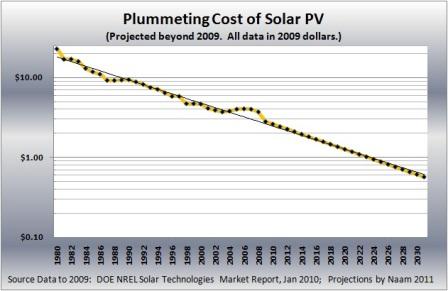You might think these solar panels covered with snow weren’t generating anything:
But they are. Not much, true, but they are generating: Continue reading
You might think these solar panels covered with snow weren’t generating anything:
But they are. Not much, true, but they are generating: Continue reading
Will you bet on the blinkered money-only policies of the current TVA Chair, or the accurate clean solar future predictions of former TVA Chair S. David Friedman?
Seven years ago S. David Friedman wrote:

“As a substitute for oil, coal, and nuclear energy, the sun can replace the three poisons with inexhaustible fuel.”
The former TVA Chairman wrote that in 2007 his boook Winning Our Energy Independence: An Energy Insider Shows How, which also says (page 4):
There are breakthroughs in new technology that promise to make the cost of solar power as low as that of coal, nuclear, and oil. Almost simultaneously in South Africa and the Silicon Valley in the United States, companies are building huge new solar factories to manufacture a paper-thin solar coating that can generate electricity that could actually lower our electric bills. These breakthroughs promise solar power at 75 percent less than today’s price. Continue reading
 The same Energy Policy Act of 2005 that
subsidized dirty oil and fracked methane including LNG exports
also funded
that oxymoron “clean” coal such as Southern Company’s Plant Ratcliffe
in Mississippi,
ethanol production lining the pockets of Monsanto, and
the $8.3 billion loan guarantee
to Georgia Power for the new nukes at Plant Vogtle.
The same Energy Policy Act of 2005 that
subsidized dirty oil and fracked methane including LNG exports
also funded
that oxymoron “clean” coal such as Southern Company’s Plant Ratcliffe
in Mississippi,
ethanol production lining the pockets of Monsanto, and
the $8.3 billion loan guarantee
to Georgia Power for the new nukes at Plant Vogtle.
 2005 was a very long time ago in solar PV years:
prices are halved, and installed solar power production is up more
than ten times and growing exponentially like compound interest.
We need to stop throwing money at dirty, water-sucking,
centralized baseload 20th century non-solutions and get on with
clean 21st century distributed solar and wind power
for jobs, for energy independence, and for clean air and water,
not to mention less climate change.
2005 was a very long time ago in solar PV years:
prices are halved, and installed solar power production is up more
than ten times and growing exponentially like compound interest.
We need to stop throwing money at dirty, water-sucking,
centralized baseload 20th century non-solutions and get on with
clean 21st century distributed solar and wind power
for jobs, for energy independence, and for clean air and water,
not to mention less climate change.
-jsq
This month’s eia report confirms that solar did exactly what former FERC Chair Jon Wellinghoff predicted: “That’s what is happening in solar. It could double every two years.” Wellinghoff’s further prediction remains on the money: “…at its present growth rate, solar will overtake wind in about ten years. It is going to be the dominant player.” Because of exponential growth like compound interest caused by ever-falling solar PV costs, solar will win like the Internet did.
U.S. Energy Information Administration (eia) wrote 22 April 2014, Solar-electric Generating Capacity Increases Drastically in the Last Four Years,
U.S. solar capacity increased significantly in the last 4 years. In 2010, the total solar capacity was 2,326 MW which accounted for a comparatively small fraction (0.22%) of the total U.S. electric generating. capacity. By February 2014, this capacity increased 418% to 12,057 MW, a 9,731 MW gain, and now accounts for almost 1.13% of total U.S. capacity. Reported planned solar capacity additions indicate continued growth
12,057 / 2,326 = 5.18 times, which is more than 2 * 2 = 4, ergo Wellinghoff was right. Continue reading
Colorado, California, North Carolina: when will Georgia catch up in solar power? What will it take to get the Georgia legislature to realize all Georgians will benefit economically from much more solar power than GA PSC in July required Georgia Power to buy? And why should we permit a methane gas pipeline to gash through Georgia to profit executives in Houston and Juno Beach, Florida when we could be deploying solar everywhere in Georgia for local jobs, profit, lower electric bills, and clean air and water?
Here’s the study that showed solar benefits outweigh costs in North Carolina, The Benefits and Costs of Solar Generation for Electric Ratepayers in North Carolina, by R. Thomas Beach and Patrick G. McGuire for Crossborder Energy, 18 October 2013.
Wholesale solar PPA prices provide perhaps the most dramatic evidence of the continued decline in solar PV costs. Solar PPA prices have fallen dramatically over the past several years, to the point that, in some regions of the U.S., solar is now competitive with other generation resources, including wind and natural gas. Xcel Energy in Colorado recently announced that it is proposing to add 170 MW of utility-scale solar to its system, with its CEO stating “[f]or the first time ever, we are adding cost competitive utility scale solar to the system.”33 The California electric utilities make public each year the average PPA prices for renewable contracts approved by the CPUC in the prior year. Figure 3 shows the trend in the prices for their solar PV PPAs; CPUC contract approval can occur up to a year or more after bids are received, so the figure is indicative of prices through roughly 2011.34 2012 solicitations for solar PPAs in California in the 3 MW to 20 MW size range through the Renewable Auction Mechanism (RAM) have yielded market-clearing prices in the 8 to 9 cents per kWh range.3
The Lawrence Berkeley National Lab (LBNL) conducts and publishes regular national surveys of the installed costs of solar PV; these surveys include Continue reading
 Somebody is willing to read the sunshine writing:
Renewables are Winning, Nukes are Dead and Coal is Crashing, as
Kathleen Rogers and Danny Kennedy wrote for EcoWatch 14 Dec 2012.
Somebody is willing to read the sunshine writing:
Renewables are Winning, Nukes are Dead and Coal is Crashing, as
Kathleen Rogers and Danny Kennedy wrote for EcoWatch 14 Dec 2012.
As I wrote back in April when formerly coal-plotting Cobb EMC went solar:
Coal is dead. Nuclear is going down. Solar will eat the lunch of utilities that don’t start generating it.
Can Georgia Power and Southern Company (SO) read that handwriting on the wall?
 They can’t fight Moore’s Law, which has steadily brought the cost
of solar photovoltaic (PV) energy down for thirty years now, and
shows no signs of stopping.
This is the same Moore’s Law that has put a computer in your pocket
more powerful than a computer
that cost hundreds of thousands of dollars in 1982
and was used by an entire company.
Solar PV costs dropped 50% last year.
Already
all the new U.S. electric capacity installed this September
was solar and wind.
As this trend continues, solar will become so much more cost-effective
than any fossil or nuclear fuel power that nobody will be able to ignore it.
They can’t fight Moore’s Law, which has steadily brought the cost
of solar photovoltaic (PV) energy down for thirty years now, and
shows no signs of stopping.
This is the same Moore’s Law that has put a computer in your pocket
more powerful than a computer
that cost hundreds of thousands of dollars in 1982
and was used by an entire company.
Solar PV costs dropped 50% last year.
Already
all the new U.S. electric capacity installed this September
was solar and wind.
As this trend continues, solar will become so much more cost-effective
than any fossil or nuclear fuel power that nobody will be able to ignore it.
Rogers and Kennedy explained this phenomenon:
The seismic shift in how we all use cell phones and mobile technology to access the internet almost snuck up on the incumbent technologies and the monopolies that made money selling us landline telephones and a crappy service. Now, we’re all using apps on smartphones all of the time. So too, the shift to a scaled, solar-powered future built around the modular technology at the heart of solar power—the photovoltaic solar cell—will come as a surprise to many. We call it the solar ascent, and it is happening every day in a million ways.
Will SO and Georgia Power continue to prop up
that 1973 legal wall
 that
inhibits solar financing in Georgia?
Companies and even economic development authorities are
starting to find ways around it,
and of course there’s
Georgia Solar Utilities (GaSU) trying to
wedge into the law as a utility.
After Hurricane Sandy,
rooftop solar for grid outage independence
has suddenly hit the big time
(Austin Energy caught onto that back in 2003).
The
U.S. military got solar and renewable energy
back in Afghanistan and are now doing it bigtime everywhere.
that
inhibits solar financing in Georgia?
Companies and even economic development authorities are
starting to find ways around it,
and of course there’s
Georgia Solar Utilities (GaSU) trying to
wedge into the law as a utility.
After Hurricane Sandy,
rooftop solar for grid outage independence
has suddenly hit the big time
(Austin Energy caught onto that back in 2003).
The
U.S. military got solar and renewable energy
back in Afghanistan and are now doing it bigtime everywhere.
SO and Georgia Power can try to ignore Continue reading
 Two professors in India have done the math and found that
there’s plenty of available land in India (much of it on rooftops)
to power its billion people on solar energy alone.
And solar uses less water than nuclear or coal, also as we already knew for the U.S.
Two professors in India have done the math and found that
there’s plenty of available land in India (much of it on rooftops)
to power its billion people on solar energy alone.
And solar uses less water than nuclear or coal, also as we already knew for the U.S.
Today in The Hindu, India can meet energy needs sans N-power: Study,
According to their study, 4.1 per cent of the total uncultivable and
waste land area in India is enough to meet the projected annual demand of 3,400 terawatt-hour (TWh) by 2070 by solar energy alone (1 terawatt-hour per year equals 114 megawatts). The land area required will be further reduced to 3.1 per cent “if we bring the other potential renewable energy sources of India into picture”, they claim. They conclude that land availability is not a limiting constraint for the solar source as believed. According to their study, 4.1 per cent of the total uncultivable and waste land area in India is enough to meet the projected annual demand of 3,400 terawatt-hour (TWh) by 2070 by solar energy alone (1 terawatt-hour per year equals 114 megawatts). The land area required will be further reduced to 3.1 per cent “if we bring the other potential renewable energy sources of India into picture”, they claim. They conclude that land availability is not a limiting constraint for the solar source as believed.
The graph above shows land occupation needed to generate 1 gigawatt hour (1GWh) for each of coal, nuclear, hydroelectric, and solar. It is Figure 3 from the actual study, Is land really a constraint for the utilitzation of solar energy in India? by H. Mitavachan and J. Srinivasan, Current Science, Vol. 103, No. 2, pp. 163-168, 25 July 2012. More from the Hindu article, with graphs from the journal article:
Continue reading
Stephen Lacey wrote for Climate Progress 12 Feb 2012,
More than 68% of New European Electricity Capacity Came From Wind and Solar in 2011,

That’s almost a 10-fold increase over deployment in 2000, when only 3.5 GW of renewable energy projects were installed. Last year, 32 GW of renewables — mostly wind and solar — were deployed across European countries.If Europe can change its energy strategy that quickly, so can we.
-jsq
PS: Owed to William House.
A letter last week asked, “Do you have solar energy yourself?” Why yes, I do.Continue readingWhen we installed solar panels on our farm workshop in 2009, the closest certified solar installer was in Marietta. There were only four in the state. Now there are forty. Georgia may yet catch up with North Carolina and even New Jersey!
Hannah Solar had all the paperwork ready when Okra Paradise Farms applied for a USDA REAP grant for more solar panels a few weeks ago. Much to our surprise,
 Plus ongoing jobs, expanded education, private sources of investment, and customers for the electricity.
Plus ongoing jobs, expanded education, private sources of investment, and customers for the electricity.
According to SolarServer quoting a National Solar press release yesterday, National Solar Power chooses Gadsden County, Florida for 400 MW PV project
The company estimates that the 400 MW project will create 400 jobs during the five-year construction phase and up to 120 permanent operations jobs.And that’s not all. According to Solar Energy News today, Plan to build $1.5bn solar farm in Florida, Continue reading